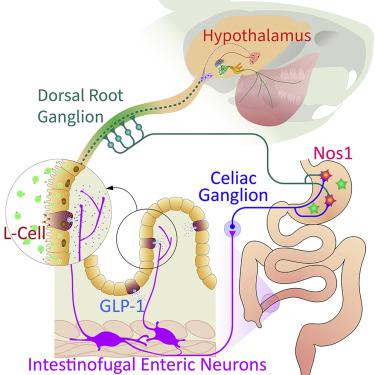Cell ( IF 45.5 ) Pub Date : 2022-06-02 , DOI: 10.1016/j.cell.2022.05.007 Tong Zhang 1 , Matthew H Perkins 2 , Hao Chang 2 , Wenfei Han 2 , Ivan E de Araujo 3

|
Glucagon-like peptide-1 (GLP-1) is a signal peptide released from enteroendocrine cells of the lower intestine. GLP-1 exerts anorectic and antimotility actions that protect the body against nutrient malabsorption. However, little is known about how intestinal GLP-1 affects distant organs despite rapid enzymatic inactivation. We show that intestinal GLP-1 inhibits gastric emptying and eating via intestinofugal neurons, a subclass of myenteric neurons that project to abdominal sympathetic ganglia. Remarkably, cell-specific ablation of intestinofugal neurons eliminated intestinal GLP-1 effects, and their chemical activation functioned as a GLP-1 mimetic. GLP-1 sensing by intestinofugal neurons then engaged a sympatho-gastro-spinal-reticular-hypothalamic pathway that links abnormal stomach distension to craniofacial programs for food rejection. Within this pathway, cell-specific activation of discrete neuronal populations caused systemic GLP-1-like effects. These molecularly identified, delimited enteric circuits may be targeted to ameliorate the abdominal bloating and loss of appetite typical of gastric motility disorders.
中文翻译:

抑制食欲的器官间神经回路
胰高血糖素样肽-1 (GLP-1) 是下肠肠内分泌细胞释放的信号肽。GLP-1 发挥厌食和抗运动作用,保护身体免受营养吸收不良。然而,尽管酶快速失活,但肠道 GLP-1 如何影响远处器官却知之甚少。我们发现肠道 GLP-1 通过肠离神经元(投射到腹部交感神经节的肌间神经元的一个亚类)抑制胃排空和进食。值得注意的是,对离肠神经元的细胞特异性消融消除了肠道 GLP-1 效应,并且它们的化学激活起到了 GLP-1 模拟物的作用。离肠神经元对 GLP-1 的感知随后参与了交感-胃-脊髓-网状-下丘脑通路,该通路将异常的胃扩张与颅面食物排斥程序联系起来。在该通路中,离散神经元群的细胞特异性激活引起系统性 GLP-1 样效应。这些分子鉴定的、界定的肠回路可用于改善胃动力障碍典型的腹胀和食欲不振。











































 京公网安备 11010802027423号
京公网安备 11010802027423号